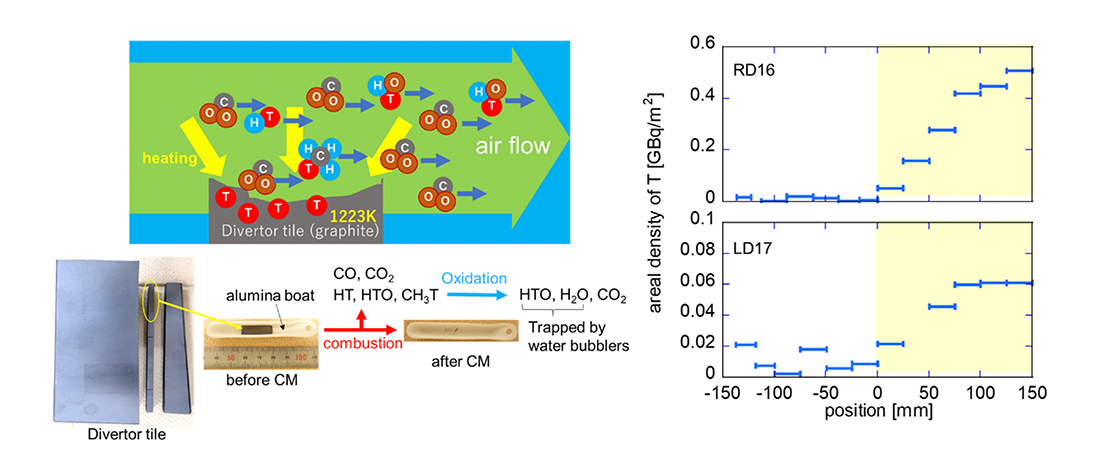Remaining tritium in graphite divertor tiles were quantitatively analyzed by using a full-combustion method
To reveal the triton transport and the tritium migration in a deuterium plasma experiment in LHD, remaining tritium in divertor tiles made of graphite was investigated by using a combustion method. Obtained remaining tritium profile in two divertor tiles were in consistent with the profile of lost-points of promptly lost high energy triton on the divertor tiles calculated by using a Lorentz orbit following code (LORBIT) with taking into account divertor components.

To reveal the triton transport and the tritium migration in a deuterium plasma experiment in the Large Helical Device (LHD), the distribution of the remaining tritium in divertor tiles was made of graphite after the first deuterium plasma experimental campaign in 2017 was investigated by using a full-combustion method. The asymmetric tritium retention in divertor tiles located at symmetric positions, which was found in the previous study by the surface tritium measurement using the tritium imaging plate technique, has been confirmed by the results of the full-combustion method. The asymmetry is likely attributed to the asymmetric distribution of lost-points of promptly lost energetic tritons, which was calculated using a Lorentz orbit following code (LORBIT) taking into account divertor components.
During the deuterium plasma experiments, high-energy tritons with a kinetic energy of 1.01 MeV were generated by one of two deuterium-deuterium fusion reactions. In the case of the Large Helical Device (LHD), the fusion reactions occurred mainly between neutral beams and thermal plasma ions. The portion of promptly lost tritons was calculated by using a Lorentz orbit following code (LORBIT), and the result of the calculation shows that the portion is approximately 40 % in case of the standard magnetic configuration (major radius of the magnetic axis, Rax, is 3.6 m, magnetic field strength, Bt, is 2.75T), and energetic tritons lost between helical coil cans, that is, in the helical divertor region.
On the other hand, evacuated gas analyses showed that approximately 35.5 % of the generated tritium was evacuated in the first deuterium plasma experimental campaign. These results suggest that more than 60 % of the generated tritium could remain in the vacuum vessel, primarily in the helical divertor region. It is worth analyzing the amount and distribution of the remaining tritium in plasma facing components from the viewpoints of understanding tritium migration in the vacuum vessel of a fusion device, and safety of in-vessel works.
The first experimental investigation of remaining tritium in plasma facing components in the LHD was conducted using the tritium imaging plate technique. The results of the investigation show that the remaining tritium densities in divertor tiles made of graphite, are much larger than those in the first wall panels made of stainless steel (type 316 L). The result of the calculation using the LORBIT code is consistent with the remaining tritium distribution obtained by using the tritium imaging plate technique. However, the imaging plate technique can detect tritium remaining within a depth shallower than the escape depth of β-rays from tritium decay. Therefore, quantitative analysis of remaining tritium in plasma facing components is necessary to reveal the tritium distribution in the LHD vacuum vessel with more accuracy than the estimation using only the imaging plate technique.
The LHD research group, in collaboration with researchers at Kindai University worked to investigate remaining tritium in divertor tiles. Tritium retention in divertor tiles made of graphite was quantitatively analyzed by using the full-combustion method. Amounts of remaining tritium on divertor tiles were compared to the lost-points distribution of energetic tritons calculated by using the improved calculation with the LORBIT code, which takes into account divertor components. To estimate the incident energy of tritium on a divertor tile, depth profile measurement of remaining tritium in a divertor tile was also conducted.
In the full-combustion method, a quartz tube surrounded by an electric heater was utilized as a reactor. A sample temperature rose to 1223 K, and was kept there around an hour. Upstream of the reactor, moist air flew into it and then air including HT, HTO, T2, CH3T, CO, CO2 and so on flew into an oxidation reactor with two palladium catalysts in which tritium in chemical forms of tritiated hydrogen gas and tritiated hydrocarbons oxidized to tritiated water vapor. The tritiated water was collected by water bubblers, and the tritium activities in them were determined by a liquid scintillation counter. By this method, a graphite sample was completely combusted, and all remaining tritium in the sample could be captured by the bubblers.
The measurements of remaining tritium in divertor tiles, RD16 and LD17, retrieved from a symmetric position after the first deuterium plasma experimental campaign using the LHD have been conducted by using the full-combustion method. Asymmetric remaining tritium in the divertor tiles was observed, and also in the previous study with the IP technique, though it was not clear whether the asymmetric tritium remaining was only near the surface or was the total amount of remaining tritium. This asymmetry is attributed to the asymmetric loss of energetic tritons to plasma facing components, caused by drifts.
This research result was published in Nuclear Materials and Energy, a journal on material application in the production of nuclear energy, on 10 December, 2020.
